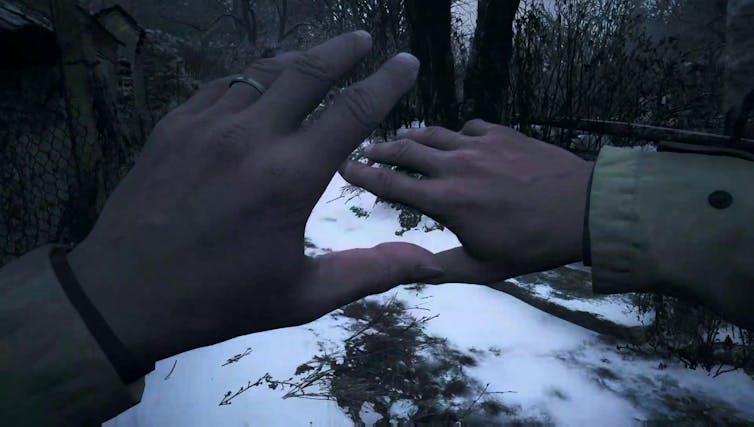Technology
‘Resident Evil: Village’ and first-person video game immersion: Why hands create intense connection

The video games “Resident Evil: Biohazard” and “Resident Evil: Village” are the most recent releases in Capcom’s long-running survival-horror series. Both games feature first-person gameplay and centre on the protagonist Ethan Winters, who is almost wholly anonymous: his face is hidden in advertisements and in the game. All we know of Ethan is a back-lit silhouette and set of hands, which is what players project onto as they play.
Some players have suggested that their experience of the damage to Ethan’s hands stays with them after playing, motivating commentaries on sites like Gamerant. On other game commentary sites like like Kotaku and IGN, writers have joked that someone at Capcom has a hatred of hands.
On the pop-culture site The Mary Sue, the site’s fandom editor discusses how Ethan’s hand damage has a significant role in how his character develops.
My research examines how game design engages players through emotional identification and physical participation.
In “Biohazard” and “Village,” players experience embodiment through Ethan’s hands, and in that experience, are encouraged to feel his trauma. The games’ use of the first-person perspective builds the cultural and psychological projection, and helps players feel like they are part of the experience.
Hands showing pain
Ethan’s hands experience numerous traumas in the two games, paired with sound and voice acting that expresses pain and suffering. His hands are cut, stabbed, bitten, slashed and removed brutally, and both games keep the hands visible throughout gameplay. In raising his hand to check his health monitor in “Biohazard,” or in his interaction with doors, ladders and gates in “Village,” players are constantly aware of the damage.
In “Biohazard,” Ethan’s left hand is violently removed with a chainsaw and inexplicably reattached with staples and medication; in “Village,” Ethan’s right hand is removed — after he has pulled hooks through his hands and had fingers bitten off. He must pick up his hand, which appears in the inventory as “severed hand.” He heals by pouring medication over his hands, removing the damage and inexplicably reattaching severed limbs.
Why do these games make us so aware of Ethan’s poor, damaged hands?
Avatars and bodies
Theories of game bodies and avatars often focus on the psychology of projection and identity. Professor of film and media studies Bob Rehak describes embodiment: “Players experience games through the exclusive intermediary of another — the avatar — the ‘eyes,’ ‘ears’ and ‘body’ of which are components of a complex technological and psychological apparatus.”
That avatar body is how we understand the game — how we play. Film theorist Torben Grodal discusses immersion as part of our emotional response.
He writes that “a player of a video game is personally responsible for the outcome.” A player’s assessment of her potential determines how she experiences the monster: with fear, if the monster presents a challenge, with despair “if he feels that he has no coping potentials” or with “triumphant aggression” if she feels “amply equipped for the challenge.” Empowerment shapes our emotional experience.
As film and video game theorist Timothy Crick notes, the player’s projection is a means to “produce high levels of dramatic tension and engagement.” However, games can shape that projection and feedback through our primary visual of the avatar’s body: the hands.
Hands are an extension of self
Our engagement with our world is often mediated by our hands, so when a game wants to highlight violence or trauma, it may start with the hands. Identifying hands as an extension of ourselves has some cultural and psychological grounding.
In English, the expression to know something “like the back of your hand” is to know something intimately.
The psychology of human association with our hands has been the focus of studies of the “rubber hand illusion,” which involves putting a rubber hand in one’s shirt sleeve and showing the fake hand receiving touch stimuli as the actual hand receives the same form of contact. Research shows this isn’t simply a mind game, as they have also observed a physical response. In just a few minutes, the brain signalling shifts to send weaker electrical signals to the real hand.
Role of sound
Sound reinforces the visuals as Ethan’s physical suffering is audible and visceral. As Elaine Scarry discusses in The Body in Pain, pain is beyond explanation and language.
Scarry notes that while we can see and sympathize with pain, drawing on our own experience, we cannot understand someone else’s pain. “Whatever pain achieved, it achieves in part through its unsharability, and it ensures this unsharability through its resistance to language.”
Ethan’s expressions are more utterance than speech: groaning while climbing a ladder with a partial hand, sounds of exertion while navigating obstacles, and yells of pain and fear. The game keeps us aware of how overwhelming Ethan’s pain is through these expressions.

Hands central to story
Ethan’s hands are also central to the story. Capcom released playable teasers of the game a couple weeks before the release of “Village” and, in both, Ethan’s hands are intact: no bandages, no missing fingers. The trailers promoting the game also show intact hands; to see the damage is to see a glimpse of his trauma.
How we experience games is a focus of game design and digital storytelling. We are invited to feel discomfort with Ethan as he fights his way through the game locations around the Romanian village. While we can’t feel Ethan’s pain, game designers encourage us to feel discomfort.
Christina Fawcett, Instructor, Department of English, University of Winnipeg
This article is republished from The Conversation under a Creative Commons license. Read the original article.





















